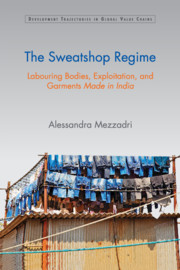Book contents
- Frontmatter
- Dedication
- Contents
- List of Tables, Figures and Pictures
- Acknowledgements
- List of Abbreviations
- Introduction
- 1 The Chain and the Sweatshop
- 2 The Commodity and the Sweatshop
- 3 Difference and the Sweatshop
- 4 The Regional Lord and the Sweatshop
- 5 The Broker and the Sweatshop
- 6 The Body and the Sweatshop
- Conclusions
- References
- Index
Conclusions
Published online by Cambridge University Press: 23 July 2017
- Frontmatter
- Dedication
- Contents
- List of Tables, Figures and Pictures
- Acknowledgements
- List of Abbreviations
- Introduction
- 1 The Chain and the Sweatshop
- 2 The Commodity and the Sweatshop
- 3 Difference and the Sweatshop
- 4 The Regional Lord and the Sweatshop
- 5 The Broker and the Sweatshop
- 6 The Body and the Sweatshop
- Conclusions
- References
- Index
Summary
The Resilience of the Sweatshop Regime across Time and Implications
At the end of our long journey into the world of the Indian sweatshop and its multiple regional manifestations in India, we cannot but appreciate the great complexity of the social questions paving its foundations. Despite endless scandals and attempts at regulation aimed at improving labour and living standards, the great resilience of the sweatshop across time appears as the final outcome of processes that go well beyond the responsibility of single actors. This resilience, in fact, appears as the overall outcome of the structuring of the sweatshop as a complex regime of exploitation and oppression, organized in a joint enterprise shaped and commanded by multiple global, regional and local lords that link processes of surplus extraction to different realms of social reproduction of the labourforce. The forms of exploitation and oppression at work in the sweatshop change based on the commercial dynamics and on the physical characteristics of the garments produced. If the seams and features of our jeans, T-shirts, shirts, sweaters or jackets are all manufactured through the heavy toil of the millions who produce our clothes today, they also conceal different stories of exploitation, social oppression, labouring and unfreedom. The process of manufacturing different garments for the global economy also does produce a greatly different garment proletariat, decomposed in multiple ‘classes of labour’ shaped by numerous social differences and divides. The sweatshop is experienced in different ways across the NCR and Bareilly, in Ludhiana, Jaipur, Kolkata, Bangalore, Chennai, Tiruppur or Mumbai. It is experienced differently by the army of UP and Bihari male migrants sweating and circulating across the NCR, by the endless numbers of home-based workers of Bareilly, by the thousands of women factory workers of Bangalore and Chennai. In fact, the ways in which these different classes of labour live the labouring reality of the sweatshop vary based on their social traits and wider conditions of social reproduction, both at their place of origin and across the industrial areas where they find work. The sweatshop constructs a social reality where commodity fetishism effectively comes to life and workers themselves are fetishized into distinct ‘raw materials’ to be deployed in different activities and tasks.
- Type
- Chapter
- Information
- The Sweatshop RegimeLabouring Bodies, Exploitation and Garments <I>Made in India</I>, pp. 185 - 210Publisher: Cambridge University PressPrint publication year: 2016



